The youngest player in the NBA right now, we first wrote about Derrick Favors almost four years ago. As top player in the 2009 high school class and a prospect we, and every other outlet in the business of covering prep and college basketball, have written about extensively over the past few years, it is easy to forget that the Atlanta native is just 19 years old. After a non-descript season in a less than desirable situation at Georgia Tech, Favors was the third overall pick in the 2010 draft thanks to the upside grounded in his tremendous physical tools, smooth athleticism, and budding skill set.
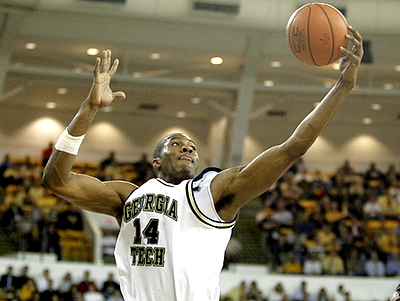
Midway through his rookie season, and sixth months away from his 20th birthday, Favors is a recent addition to the New Jersey starting lineup despite only managing to blend in on a 10-30 Nets team. Much like the rest of the 2010 rookie crop, the raw power forward hasn't hit the ground running or surprised anyone with his play or progress, averaging 6.6 points and 4.9 rebounds on the year in relatively consistent minutes off the bench, despite regular foul trouble.
Though John Wall and Blake Griffin have set the world on fire as rookies, it is important to remember that Favors was not a college star. Few expected him to show more than flashes of things to come this season, and considering the looming trade speculation he's had to deal with, the dysfunctional team he's playing on and the dry spells he fought through at Georgia Tech, it is surprising that he hasn't hit the rookie wall or grown frustrated on the bench.
Some of Favors's steady but unspectacular performance can be explained by his role offensively, and while there's a lot of basketball left to be played this season, Favors seems to have found a niche, at least for the time being, as a hustle player. If nothing else, this season has been a promising one for Favors as he's gotten a taste of what it means to be a pro without taking any steps backward. The question is when he'll begin to take the steps forward that made him a top prospect.
Part One: Role
Then:
Due to the situation he's in, he's been forced to create too much of his offense by himself this year, which is not something he's comfortable doing at this point in time
Whoever drafts him must be patient though, as it's unlikely that he'll be ready to compete for Rookie of the Year honors, and he surely isn't ready to play a major offensive role right away. Players with his natural tools are incredibly hard to come by, though, which is exactly why he won't have to wait very long before hearing his name called on draft night.
-NCAA Weekly Performers, 2/16/10
Now:
One of the biggest factors in Favors's consistency as a rookie has been the role he's played offensively. As we noted last spring, the athletic big man appeared raw when looking to create his own shot with his basket, something he was forced to do regularly out of necessity since the guards around him struggled to create easy looks for him. Some 35% of Favors's touches came in post-up situations in his single college season, despite his relatively weak footwork and inability to establish great position down low. That type of usage is usually reserved for polished, experienced underclassmen, not an untested freshman only scratching the surface of his potential.
This season, post-ups have accounted for just 13.3% of Favors's possessions according to Synergy Sports Technology. This sharp decline in post usage has allowed Favors to play to his strengths, mask many of his weaknesses, and play low-turnover basketball, but has also limited his opportunity to experience the learning curve all young big men face in developing their skill-level as well. Though the role he's playing is more tailored to a third or fourth big off the bench, it aligns well with what we've seen from him in the past and has allowed him to gain experience and develop at his own pace.
Playing next to Brook Lopez, Favors has functioned almost exclusively as a complementary, hustle playerwhich makes sense considering his post repertoire and jump shot have not emerged as consistent tools for him. Averaging under five field goal attempts per game this season, Favors has not yet shown to be ready to be a first, second, or even third option for the Nets. His athleticism has been a great asset since he hasn't been asked to create his own offense, knock down midrange shots, or make plays in crunch time.
While he's clearly being brought along slowly, his current level of efficiency isn't a giant step back from where he was last season, and there is something to be said for showing well in limited action. Unfortunately, his skill set has not undergone any major changes.

Part Two: Post Offense
Then:
Offensively, Favors is fairly limited as a shot-creator in the half-court, showing raw footwork and little in the ways of a go-to move, struggling to finish with his left hand and being fairly turnover prone when forced to put the ball on the floor
He has good touch around the basket and a very nice looking jump-hook shot, but still hasn't grown into his outstanding frame quite enough to establish deep position in the paint.
Now:
Despite post play not comprising a big part of his offensive role, Favors has made some subtle improvements in his rookie season that are worth noting, even if he hasn't made any major strides from last season. The most notable improvement Favors has made lies in his ability to turn over his right shoulder on the block and use his left hand. Though he showed a willingness to use his left hand in the post last season, he often looked uncomfortable and out of control doing so. Clearly more patient this season, Favors's lack of footwork still limits his ability to create good looks for himself around the basket, and while he hasn't converted many of the left handed hooks he's attempted, his touch with his left hand appears softer than it was at Georgia Tech.
Though that wrinkle in his scoring ability bodes well for his development, it hasn't spelled production in the short-term and is just one of a bevy of areas Favors will need to work on to reach his long-term potential. Still learning how to use his athleticism at the NBA level, Favors has done a better job establishing position on the block, but needs to continue working on his exceptional frame to make the game easier for himself. He'll also need to polish his post moves to improve on his less than ideal 36.7% shooting in post-up situations. He's cut down considerably on the shots he takes moving away from the rim, but still hasn't found a comfort zone or go-to-move in the paint.
Still a ways away from developing the blend of polished footwork and calculated explosiveness that allows players like Amare' Stoudemire to dominate offensively, Favors's ability to develop a comfort level creating and finishing scoring opportunities this summer will be key to what he's able to contribute next season.
Part Three: Overall Offense and Mentality
Then:
Favors converts a super-efficient 59% of his field goal attempts, a testament to his terrific finishing ability. Unfortunately he takes only 7.5 shots per game, as his teammates are often unwilling or unable to get him the ball in a position to score. The more wide open style of the NBA game should benefit him in this regard, both in transition (where he truly excels) and as a pick and roll finisher in the half-court.
Favors' agility makes him a magnet for drawing fouls, but he hasn't been able to knock down his free throws at a very consistent ratehitting just 59% of his attempts. He shows great potential with his long strides and terrific first step, but is still too raw to be relied on consistently in isolation situations. Nevertheless, this is an area he can improve in rapidly with the better spacing he'll find in the NBA.
As a jump-shooter Favors has been incredibly streaky over the course of the year His shooting mechanics don't look terrible, especially when he's not rushing his shots (an issue at times), but some of the bad misses he has on occasion certainly do. This is unfortunate considering the strides we saw him make from the perimeter over the course of his high school career.
-NCAA Weekly Performers 2/16/2010
Now:
While Favors still has a ways to go in the post, the things he did and did not do well on the college level have manifested themselves in his numbers as a rookie. He still struggles with his jump shot and is limited from the foul line, but with nearly two-thirds of his offense coming in basic catch-and-finish situations resulting from offensive rebounds, cuts, transition, or rolls to the basket in the two-man game, Favors has been able to rely on the length and athleticism that made him an efficient college scorer.
Using the same agility and explosiveness we noted in our scouting report last season, Favors has been able to get the job done around the rim in the NBA, even if he's not quite as prolific as he was in the college game. Ranking amongst the top offensive rebounders in the NBA per-40 minutes pace adjusted and in the top 20 in FG% amongst qualified players in the entire NBA, Favors is shooting an excellent 62.3% around the basket according to Synergy Sports Technology and continues to get to the foul line at a solid rate despite seeing his one-on-one opportunities decline significantly.
While Favors's efficiency as a finisher is already living up to expectations, Avery Johnson has made it clear that he wants to see more from the rookie forward. Though his laid back demeanor has helped him weather constant trade speculation, Favors doesn't show the type of fire on the court that would help him take his game to the next level. He isn't the type of player that imposes his will on opposing defenders at this juncture, whether that be in the post or when scrapping for a rebound.
One of the most important pieces of the puzzle for Favors as he matures will be his assertiveness and intensity on the offensive endsomething that we've noted going back to his high school days. His activity level is more than passable, as evidenced by his offensive rebounding numbers, but to help ease his transition from bench player to full time starter, he'd benefit immensely from being more aggressive on the offensive end, even if that simply means making a concerted effort to exploit his speed in fast break situations or making contact with defenders around the rim whenever a shot goes up.
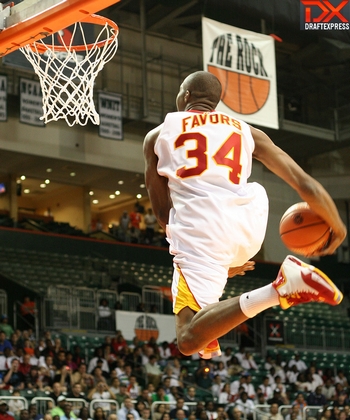
Part Four: Physical Tools and Defense
Then:
Favors is incredibly gifted from a physical standpoint, showing a combination of length and athleticism that is simply unparalleled at the college level. He runs the floor like a deer, is outrageously explosive around the rim, and is a fantastic target for entry-passes thanks to his terrific hands and the amazing extension he gets around the basket.
Defensively, Favors has all the tools needed to become an elite player down the road, even if his lack of experience definitely shows at times, mainly in the form of cheap fouls. His terrific length and timing already make him an imposing shot-blocking threat at the college level, and his excellent lateral quickness allows him to step out onto the perimeter, hedge screens and stay in front of smaller players attacking the basket with the greatest of ease. As he gets stronger, he shouldn't have too much of an issue seeing minutes at the center position from time to time in smaller up-tempo lineups in today's NBA.
Now:
Looking back on our take on Derrick Favors's athleticism from last season, it isn't hard to see why he's been so effective on the offensive glass and why many of the assertions we made about his defensive presence still ring true in the NBA, for better or worse.
While Favors has had some success in terms of efficiency on the offensive end, his overall productivity has clearly been limited by his inability to stay out of foul trouble. Ranking as the most foul prone player in the NBA averaging over 15 minutes per game, Favors can't seem to buy a break on the defensive end, looking a bit too aggressive at times, and a bit too tentative in others.
His lateral quickness allows him to defend the perimeter and midrange very effectively for a rookie power forward, but his lack of fundamentals and discipline in the post render him less than effective against savvy veterans with advanced back to the basket skills. Favors's 7'4 wingspan is a constant factor when he's contesting shots, allowing him to close out shooters quickly and give a bigger cushion when is rotating to the outside. Unfortunately, it doesn't always help him in post, where he has a hard time staying on his feet and being physical without fouling.
A gifted rebounder who boxes out well, Favors has all the making of a fine defender on the NBA level. The tools are there, it is just a matter of how quickly he develops the fundamentals to use them.
Outlook
Looking back at what we wrote about Favors last season and analyzing what he's accomplished so far in the NBA, we can safely draw many of the same conclusions we did last season. An athletic marvel too gifted not to make an impact on the glass and around the rim in his time on the floor, Favors is too raw on both ends of the court to factor into Rookie of the Year conversations. While players like Landry Fields have outplayed their draft stock by a pretty considerable margin, we won't be able to draw any definitive conclusions about Favors for at least another year or two.
Still, it's not difficult to be excited about his upside, especially when you consider how rare (and important) players of his nature are in today's NBA. In a more stable situation, playing with a better playmaking point guardsuch as Ty Lawsonon a more fast-paced team (New Jersey is the 4th slowest-paced team in the NBA, while the Nuggets are the 2nd fastest), there is no reason not to expect Favors to develop rapidly as he enters his 20's.













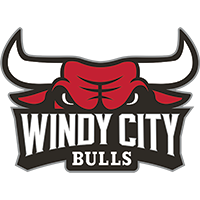




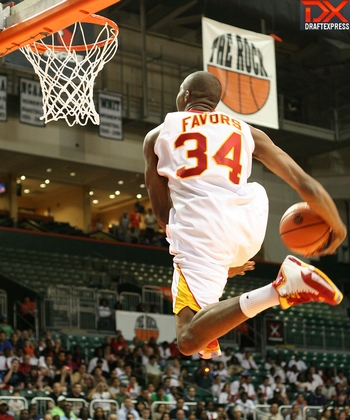

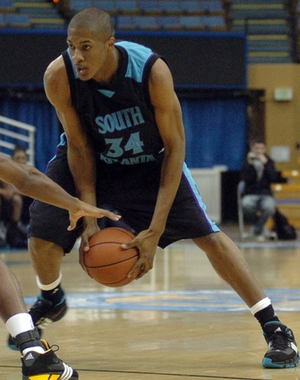








Comments